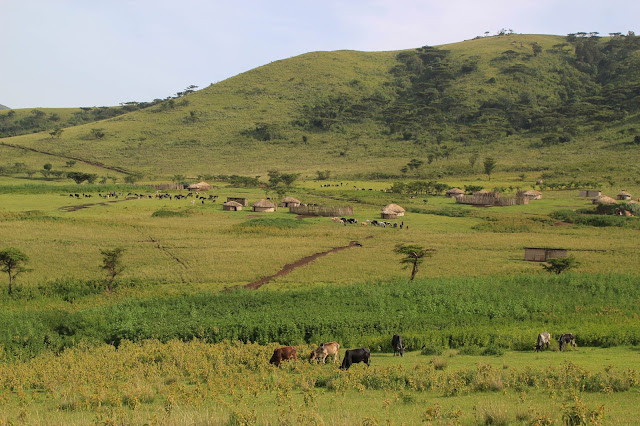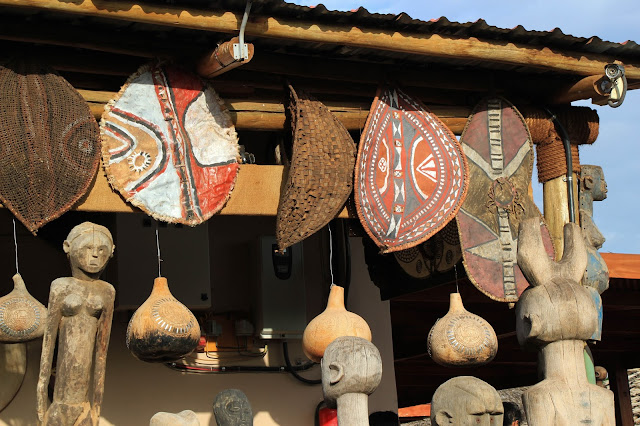It is nearly impossible to avoid encounters with the Maasai on any trip to East Africa, and honestly, it would be sad to try to do so. The Maasai exemplify one of a great many types of African tribes that spans back through ancient human history, right back to our earliest history. For those that do seek out experiences with Maasai, there are some amazing outfits and opportunities to get an in depth and personal view of how this tribe lives and why they so proudly and devotedly embrace and cling on to their traditional lifestyles in direct contrast to a rapidly changing and immensely different modern world.
Maasai women singing... and a really cute young girl taking it all in.
Maasai men, looking suave.
Maasai are proud people and traditionally fierce warriors. This village of folks was really cool all around from what I could tell; my friends and I had a great time meeting them. I hope this post does some justice for the richness of their history and culture and how this is just one of many, many, many African tribes that still embrace their traditions and root cultures.
Maasai live a semi-nomadic lifestyle. They rely solely on livestock for their food, growing no fruits or vegetables. Remarkably, they traditionally lived on a diet of almost entirely meat, milk, and blood. As nomads, their villages are not permanent. Once pastureland stops providing, they move on and start anew elsewhere. They have been living this way, in the dangerous wilds of East Africa, for hundreds and even thousands of years, and despite the governments of Kenya and Tanzania trying to get them to embrace modern society, the Maasai refuse. They prefer their traditional lifestyle to all that.
So, the Maasai are still herding, with the modern world steadily encroaching in on their territory. Though the modern world may be the latest challenge to their way of life, it isn't the oldest. This is lion country, and the Maasai have lived here and succeeded here alongside the lions (as well as all the other extremely dangerous animals in this part of the world).
A common sight along the roads outside of Arusha: Maasai herders and shepherds tending their cattle and sheep.
As we drove between national parks, Maasai villages flitted past on either side of the highway. Most blend pretty well into the surrounding terrain; there is no doubt that the Maasai live a much more environmentally friendly lifestyle than the average human being.
All over the continent, many people get around on foot over tremendous distances. Maasai country is no different.
Old meets new.
I loved these shots... views like this are iconic of the region and testament to the proud sense of tradition and heritage upheld by most Maasai, as they cling on dearly to their nomadic lifestyle and traditional garb.
There are plenty of intercity buses in Tanzania and Kenya... but these are expensive, and the average villager doesn't have the money to afford using them, or often even the local buses for that matter.
All around, there are hints of the modern world creeping in: bikes, motorcycles, and mobile phones. In this shot, I especially loved how the people on the left side were using that giant termite mound for its shade.
So many of the herders and shepherds were children... and they were doing it alone. Impressive but quite sad too. Such lonely experiences in places where large predators still stalk must inevitably produce brave, strong adults.
I loved this scene...
The cattle were clearly excited about reaching water.
We got lots of friendly waves hello as we passed by. I wonder what they think of our smiling, gawking faces peering out at them from the safari vehicle as it races past...
Quite the life, eh?
Now, onto our village visit; we were greeted in style! After our safari through Tarangire National Park, we made a stop at this Maasai village. Such opportunities are common around Arusha, and I highly recommend it. You have the amazing chance to learn about Maasai culture firsthand in addition to bringing revenue into the village.
Each robe is slightly different. Traditionally, the men wear red and the women purple or blue. This has something to do with lions... so much of the Maasai life is based on coexistence with lions. Also, check out the sandals on those wearing them... most are made from recycled car tires.
The greeting ceremony continued with the men aligning themselves on one side and the women on the other. The singing continued as the men took turns stepping forward and jumping vertically in place. They kept their torsos, arms, and heads completely still as they did this...
And these guys had some serious vertical skills...
This is apparently a tradition of the Maasai. The jumping is meant to show the physical fitness of the men, both as a form of courtship for the ladies as well as a form of mild intimidation for visiting (potentially rival) tribes.
The ladies were getting in on the jumping too! Each of the women in the tribe wore beautiful beaded disk necklaces, and as they danced they they bobbed the necklaces up and down with slight shrugs of their shoulders.
Maasai are often easily recognized by their tribal markings and scarring. These include facial scarring on the cheeks under the eyes and missing teeth that have been pulled. Piercings and the stretching of earlobes via piercings are also common.
Short swords and studded clubs: the only weapons used in defense against freaking lions! Traditionally, a Maasai male wasn't considered a man until he had gone into the bush and killed a lion by himself with only those tools. Now, the Maasai don't actively hunt lions, instead they track lions using radio collars as they move through Maasai territory and have a successful warning network that lets people in the vicinity of lions actively avoid them, resulting in fewer fatal or harmful human-lion interactions.
These guys look like they're flying... such high vertical jumps. Like I said above, they also kept their heads and torsos damn near still while doing this. It was an impressive display of athleticism and control.
They clearly started having a bunch of fun with this too as it went on...
Next we got a demonstration of starting fire... using the old school method of rubbing two pieces of wood together. They made this look oh so easy, but as a camper who has tried this, I assure you, it is not at all easy.
As a nomadic herder, being able to make a fire is a critically important skill to possess. It may be equatorial Africa, but that doesn't mean that it doesn't get cold at night. Fire is also a very effective method for keeping large predatory animals away from camp. I can't even begin to imagine what it is like to spend dark night after dark night outside and alone in the bush - in lion and leopard and wild dog territory - surrounded by a herd of prey species. I don't know if I have the fortitude of will to do that, and I am certain that I don't have the necessary skill-set. Basically, I have a huge amount of respect for these people.
Inside one of the homes. Remember, these are nomadic people: these are just temporary shelters that they will eventually abandon and leave to return to the earth. When they move on, they rebuild elsewhere hopefully near greener pastures.
Outside one of the homes... they are even more simple on the outside than they are on the inside. Maasai villages are surrounded by a rudimentary fence consisting of a high wall of thorns (acacia branches) to deter animals from coming in.
The livestock pens were often right in the middle of town too and consisted of another ring of thorn walls. Some of the more permanent settlements had wooden fences like this one.
The Maasai apparently keep donkeys too.
This scene blew my mind for how idyllic and serene it was. I know life there is not easy or gentle, but the setting certainly is beautiful.
I'm just going to let these pics speak for themselves... not much else I can say about them other than how impressed and respectful I was by the Maasai way of life.
This is all Maasai territory... it is beautiful.
Back on the highway, we passed small towns on the way towards Ngorongoro. Tourism is quite obviously the major source of income for so many people in this area.
Moving up from the lowlands around Lake Manyara into the highlands surrounding Ngorongoro Crater. These forested regions are primo leopard territory, and the Maasai avoid such terrain, which is simply not ideal for herding (due more to the trees than the leopards I think).
Maasai security guards: a common sight. Due to their reputation as fierce warriors and the Maasai pride in their warrior history, many young men seek employment in the cities and tourist destinations as security guards. These three were all working at a souvenir shop and restaurant outside of Ngorongoro.
As with so many markets catering to tourists in Africa, this one tended to be more of a pan-African market, with goods and styles from all over Sub-Saharan Africa.
This statue was simply amazing... note that each figure is unique AND that you can see through it! It was carved from a single piece of wood (the trunk of a large tree) using techniques that are unique to one local tribe. It must have taken the artists an enormous amount of time to complete it, and I'm betting the shopkeep was charging a small fortune for the masterpiece.
It was tall.. it had to be over 10 feet tall, and the figures stretched the whole way up.
The Maasai life seems like it is often a lonely one. I wonder if that is one of the reasons that mobile phones are so popular amongst them (as well as for the more obvious safety reasons). Again, I have the utmost respect for this group of people, the type of life they live steeped in their traditions, and how proudly defiant they are to conform to the ways of modern society.





















































No comments:
Post a Comment